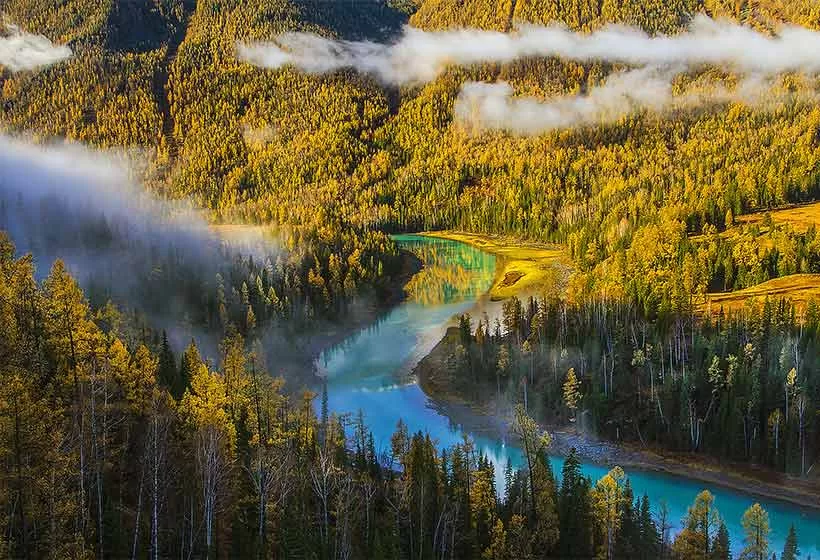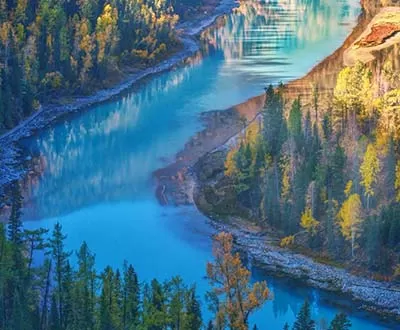Short Introduction to Kanas Local Culture: History, Nation, Heritage, etc.
The allure of the Kanas Scenic Area lies not only in its breathtaking natural landscapes but also in its rich cultural and historical heritage. The region is home to minority ethnic groups such as the Kazakhs and Tuvans, who have preserved their unique traditional lifestyles and cultural customs. Visitors have the opportunity to immerse themselves in the vibrant traditions of these communities, experiencing firsthand the charm of this diverse cultural tapestry.
Brief History
Kanas is situated on the sunny side of the Altai Mountains, a region that has historically served as a grazing land for numerous northern nomadic tribes. The discovery of microlithic sites on the northern bank of the Irtysh River suggests that human activities have been taking place here as far back as 8,000 to 9,000 years ago.
In 1755 during the Qing Dynasty, after the suppression of the Dzungar Khanate, this region came under the jurisdiction of the Uliasutai Left Vice-General for Border Defense. In 1904, the area was administered by the Altay Minister.
After the establishment of the People's Republic of China, in 1980, the People's Government of Xinjiang Uygur Autonomous Region approved the establishment of the Kanas Nature Reserve.
In 2000, the Kanas National Nature Reserve was transferred to the Altay Prefecture according to the principle of "local management".
In 2006, a unified management system was implemented for the development, utilization, and protection of Kanas' regional resources.
Ethnic Culture
Kanas is a region where multiple ethnic groups coexist, including the Han, Kazakh, Mongolian, Hui, and Uyghur peoples. These diverse communities live together within the scenic area, creating a unique cultural landscape and social structure.
- Kazakh
The Kazakh people are one of the main ethnic groups around Kanas Lake, leading a primarily nomadic lifestyle. Their culture fosters bravery and hospitality, with a deep connection to horses and exceptional horseback skills. Kazakh long songs are renowned for their unique charm, and their hospitality is legendary, making guests feel at home.
- Mongolian Tuva
The Tuvan people, who are part of the Mongolian ethnic group, primarily reside in Kanas Village and Hemu Village, where they mainly engage in hunting and herding. Known for their bravery and strength, they are skilled horsemen and are also known for their singing and dancing, who live in steeply-pitched wooden cabins made of logs.
Ethnic festivals
- Nawruz Festival
With a history of 3,000 years, the Nawruz Festival is the Uyghur New Year celebration. From the evening of March 20th to 22nd, the festival is heralded by beating the Nawruz drums at midnight, inviting everyone to gather for singing and dancing until dawn. The next day, Uyghur people bathe, change out of winter clothes, and enjoy Nawruz meals, exchanging these meals with neighbors as a New Year's greeting.
- Aobao Festival
The Aobao Festival is a significant celebration for the Tuvan people. Between the lunar months of May and July, herders gather with their families, collecting stones to add to the sacred Aobao mound, then place statues of deities and arrange offerings. Led by a living Buddha and lamas, the community circles the Aobao while chanting prayers, seeking blessings for favorable weather and thriving livestock.
- Winter Festival
The Winter Festival is a unique Tuvan holiday celebrated on the 25th day of the tenth lunar month to commemorate the passing of the living Buddha Mahakala and to pray for a safe winter. Celebrations typically include temple rituals, sheep slaughtering, and eating millet rice.
Cultural Heritage
Kanas is home to the significant Kanas Tomb Complex, a cultural site recognized as a National Key Cultural Relic Protection Unit. Located near the Tuvan New Village, this burial site dates back approximately 2,000 years and consists of over 60 tombs, which are of great importance for the study of the local archaeological culture and its historical sequence. In addition to its archaeological significance, Kanas is rich in intangible cultural heritage. One notable example is the Tuvan Tsuur, a traditional wind instrument that is the only surviving musical instrument of the Tuvan people, with its crafting, playing techniques, and distinctive sound and musical form all bearing a mysterious and timeless quality.
Customize Your Unique Kanas Scenic Area Tour

If you are interested in one of the Kanas itineraries mentioned above, please contact us, and we will be happy to customize it and provide a quote tailored to your preferences.
Alternatively, if you would like to customize your Kanas Tour, please visit our Kanas Tour Customized Center. We assure you that you will receive a reply within 24 working hours.
Informative Articles for Your Kanas Trip
 Kanas Lake
Kanas Lake- Travel Guide: attractions, hotels, food, itineraries, etc.
- Travel itineraries: best itineraries for your reference
- Weather: the best time and seasons to visit Kanas
- Top attractions: recommended things to do in Kanas
- Unique perspective: top different things to do
- Local food: what to eat while traveling in Kanas
- Luxury hotels: where to stay in Kanas
GREAT FAMILY CHINA TOUR
JULY 2024 We wanted to thank Grace at China Culture tour for organizing a great tour of China. We enjoyed our Beijing - Xian-Chengdu -Guilin -Yangshuo - Shanghai trip. Our local guides Bruce in Beijing, Susan in Xian, Jane in Chengdu, Mike in Guilin and Mary in Shanghai took care of us…read more details »
Teng Han L from SINGAPORE
Ready to Create a Unique Dream Travel?


